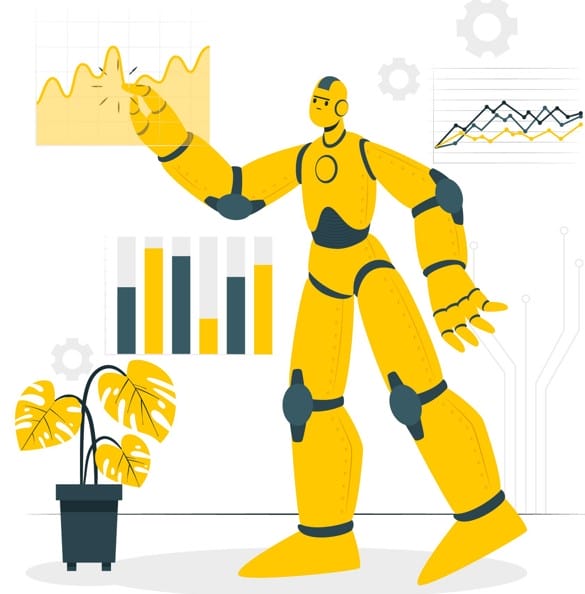AI crypto trading bots operate through a combination of sophisticated algorithms, data analysis, and automation. These bots are designed to emulate human decision-making processes but at a much faster and more efficient pace. Here’s a detailed look at the key components of how these bots function:
Unveiling the Key Benefits of Integrating AI into Crypto Trading Bots
In the dynamic landscape of cryptocurrency trading, the integration of artificial intelligence (AI) into trading bots has emerged as a game-changer. This article explores the myriad benefits that come with incorporating AI into crypto trading bots, offering traders a competitive edge in the market.Cryptocurrency markets are known for their volatility and complexity, presenting both opportunities and challenges for traders. In the quest for more efficient and profitable trading strategies, the integration of artificial intelligence (AI) into crypto trading bots has become increasingly prevalent. Let’s delve into the key benefits that arise from leveraging AI in the realm of crypto trading bots.
- Enhanced Decision-Making:
- One of the primary advantages of integrating AI into crypto trading bots is the ability to make more informed and data-driven decisions. AI algorithms can analyze vast amounts of market data at speeds beyond human capability, identifying patterns and trends that may be imperceptible to human traders.
- 24/7 Operation:
- Unlike human traders who need rest, AI trading bots can operate 24 hours a day, seven days a week. This continuous operation allows them to react swiftly to market changes, execute trades in real-time, and capitalize on opportunities that may arise outside regular trading hours.
- Risk Management and Mitigation:
- AI-powered trading bots excel in implementing robust risk management strategies. These bots can set predefined risk parameters, automatically execute stop-loss orders, and adjust position sizes based on market conditions. This helps mitigate potential losses and protect the trader’s capital.
- Adaptability to Changing Market Conditions:
- Cryptocurrency markets can be highly dynamic, with sudden shifts in sentiment and volatility. AI trading bots are designed to adapt to these changing conditions. Machine learning models enable the bot to learn from historical data and adjust its strategies, ensuring relevance in different market scenarios.
- Backtesting for Strategy Optimization:
- Before deploying a trading strategy in a live market, AI trading bots undergo extensive backtesting. This involves running the bot’s algorithm on historical data to assess its performance. This iterative process allows traders to optimize and refine their strategies, increasing the likelihood of success in live trading.
- Reduced Emotional Bias:
- Emotional decision-making can be a significant challenge for human traders, often leading to impulsive actions and suboptimal outcomes. AI trading bots operate without emotions, ensuring that trading decisions are based solely on data and predefined rules. This reduces the impact of emotional bias on trading performance.
- Efficiency and Speed:
- AI-powered bots can execute trades at speeds far surpassing human capabilities. In the fast-paced world of cryptocurrency trading, where market conditions can change rapidly, the ability to act swiftly is a crucial advantage. AI bots can capitalize on price discrepancies and execute trades with minimal latency.
- Diversification of Strategies:
- AI allows traders to implement and test a wide range of trading strategies simultaneously. This diversification helps spread risk and increases the likelihood of finding profitable opportunities in different market conditions.
Navigating the Security Landscape: Evaluating the Safety of AI Crypto Trading Bots
In the rapidly evolving landscape of cryptocurrency trading, the integration of artificial intelligence (AI) into trading bots has revolutionized how traders approach the market. However, with this technological advancement comes a critical question: Are AI crypto trading bots safe and secure?
Understanding the Concerns:
The concern surrounding the safety of AI trading bots primarily revolves around potential vulnerabilities that could be exploited by malicious actors. Here are some key considerations when evaluating the safety and security of these bots:
- Data Security:
- AI trading bots rely on extensive data analysis to make informed decisions. Ensuring the security and privacy of the data used by these bots is paramount. Reputable bots implement robust encryption protocols to safeguard sensitive information from unauthorized access.
- Code Vulnerabilities:
- The underlying code of AI trading bots is a crucial aspect of their security. Vulnerabilities in the code could be exploited by hackers to manipulate trades or gain unauthorized access. Developers of trustworthy bots conduct rigorous code audits and implement best practices to minimize these risks.
- Exchange Integration:
- AI trading bots interact with cryptocurrency exchanges to execute trades. The security of these interactions is crucial to prevent unauthorized access to trading accounts. Bots should use secure APIs (Application Programming Interfaces) and adhere to exchange security standards.
- Authentication and Authorization:
- Strong authentication mechanisms are essential to ensure that only authorized individuals can access and control the trading bot. Multi-factor authentication (MFA) adds an extra layer of security by requiring multiple forms of identification.
- Regular Updates:
- Security is an ongoing process, and regular updates to the trading bot’s software are essential to patch vulnerabilities and address emerging threats. Users should choose bots developed by teams committed to continuous improvement and security updates.
Measures to Ensure Safety:
- Reputation and Reviews:
- Before choosing an AI trading bot, it’s crucial to research the reputation of the platform and read user reviews. Established and reputable bots with positive feedback are more likely to prioritize security.
- Transparency:
- Transparent communication from the developers regarding the bot’s security measures instills confidence in users. Knowing how the bot handles data, secures connections, and manages potential risks is vital for informed decision-making.
- Third-Party Audits:
- Some trading bots undergo third-party security audits to validate their safety measures. Independent audits provide an additional layer of assurance regarding the bot’s code integrity and security practices.
- User Education:
- Educating users on security best practices, such as setting strong passwords, enabling MFA, and regularly updating software, contributes to a safer trading environment.
A Beginner’s Guide to Embarking on the AI Crypto Trading Bot Journey
The world of cryptocurrency trading has evolved significantly, and with the advent of artificial intelligence (AI), trading bots have become powerful tools for both seasoned investors and beginners alike. For those new to the realm of AI crypto trading bots, getting started may seem like a daunting task. This guide aims to demystify the process and provide beginners with the necessary steps to embark on their journey.
Understanding the Basics:
- Educate Yourself on Cryptocurrency:
- Before diving into AI trading bots, it’s crucial to have a solid understanding of the cryptocurrency market. Familiarize yourself with different cryptocurrencies, blockchain technology, and the fundamental concepts that drive the market.
- Learn the Basics of Trading:
- Acquire a basic understanding of traditional trading concepts. Learn about market orders, limit orders, stop orders, and other fundamental principles that form the basis of trading strategies.
- Explore AI and Machine Learning:
- While not mandatory, having a foundational understanding of AI and machine learning can enhance your comprehension of how AI trading bots operate. There are numerous online resources, courses, and tutorials available for beginners in these fields.
Choosing the Right AI Trading Bot:
- Research and Compare Bots:
- There is a myriad of AI trading bots available, each with its own set of features, strategies, and user interfaces. Research and compare different bots, considering factors such as user reviews, security features, and the bot’s track record.
- Understand Bot Features:
- Look for bots that offer a user-friendly interface, customizable strategies, risk management tools, and clear documentation. Understanding the features of the bot will be crucial as you start using it for actual trades.
- Start with a Demo Account:
- Many AI trading bots provide demo accounts that allow users to practice trading without risking real funds. This is an excellent way for beginners to familiarize themselves with the bot’s interface and test different strategies in a risk-free environment.
Getting Started with Your First Trade:
- Connect to an Exchange:
- Once you’ve selected a trading bot, you’ll need to connect it to a cryptocurrency exchange. Ensure that the bot supports the exchange you plan to use and follow the setup instructions provided by the bot’s developers.
- Set Risk Parameters:
- Before initiating your first trade, configure risk parameters such as stop-loss levels and position sizes. This step is crucial for managing potential losses and protecting your capital.
- Start Small:
- As a beginner, it’s advisable to start with a small amount of capital. This allows you to gain experience without exposing yourself to significant risks. You can gradually increase your investment as you become more comfortable with the bot and its performance.
Continuous Learning and Optimization:
- Monitor Bot Performance:
- Regularly check the performance of your AI trading bot. Monitor its trades, review its decisions, and assess its overall effectiveness in different market conditions.
- Optimize Strategies:
- Over time, consider optimizing your trading strategies based on the bot’s performance and market trends. This may involve adjusting parameters, exploring new strategies, or incorporating additional indicators.
- Stay Informed:
- The cryptocurrency market is dynamic, and staying informed about market news, regulatory changes, and emerging trends is crucial for successful trading. Subscribe to relevant news sources and community forums to stay updated.
Decoding the Algorithms: Strategies Employed by AI Crypto Trading Bots for Informed Decision-Making
In the fast-paced and volatile world of cryptocurrency trading, the role of AI-powered trading bots has become increasingly prominent. These bots leverage sophisticated algorithms and machine learning models to make informed decisions and execute trades in real-time. Understanding the strategies employed by AI crypto trading bots is crucial for traders seeking to harness the power of automation in their investment endeavors.
Trend Following Strategies:
- Moving Averages:
- AI trading bots often employ moving averages as a trend-following indicator. The bots analyze the historical average prices over specific time intervals to identify trends. For instance, a bot might consider a bullish trend if the current price is above its moving average.
- Relative Strength Index (RSI):
- RSI is a momentum indicator widely used by AI trading bots. It measures the speed and change of price movements, helping bots identify overbought or oversold conditions in the market. Bots can use RSI to make decisions on entering or exiting trades.
- Bollinger Bands:
- Bollinger Bands provide a range within which the price of an asset is expected to fluctuate. AI bots can use this information to identify potential breakout or breakdown points. When the price moves outside the bands, it may signal a change in market conditions.
Mean Reversion Strategies:
- Statistical Arbitrage:
- AI trading bots may engage in statistical arbitrage, exploiting perceived mispricings between different assets or markets. These bots identify deviations from historical price relationships and execute trades with the expectation that prices will revert to their mean.
- Pairs Trading:
- Pairs trading involves simultaneously buying and selling correlated assets. AI bots identify pairs of assets that historically move together and execute trades when there is a deviation from the normal price relationship. This strategy capitalizes on the expectation that the prices will converge again.
Machine Learning Strategies:
- Pattern Recognition:
- Machine learning algorithms enable AI trading bots to recognize complex patterns in historical and real-time market data. These patterns may include price trends, chart formations, or anomalies that human traders might overlook. The bot then uses this information for decision-making.
- Sentiment Analysis:
- Some advanced AI bots incorporate natural language processing and sentiment analysis to gauge market sentiment. By analyzing news articles, social media, and other sources, bots can assess the overall sentiment towards a particular cryptocurrency and make decisions based on the collective mood of the market.
Risk Management Strategies:
- Stop-Loss and Take-Profit Orders:
- AI trading bots implement risk management by setting stop-loss orders to limit potential losses and take-profit orders to secure profits at predefined levels. These automated orders help ensure disciplined trading and protect the trader’s capital.
- Position Sizing:
- Effective position sizing is a critical aspect of risk management. AI bots determine the size of each trade based on factors such as account size, risk tolerance, and market conditions. This strategy helps maintain a balanced and diversified portfolio.
High-Frequency Trading (HFT) Strategies:
- Arbitrage Opportunities:
- High-frequency trading bots capitalize on price differences across different exchanges or trading pairs. By executing trades at extremely high speeds, these bots take advantage of fleeting arbitrage opportunities.
- Market Making:
- Market-making strategies involve placing a large number of orders on both the buy and sell sides of the order book. HFT bots profit from the bid-ask spread, providing liquidity to the market.





